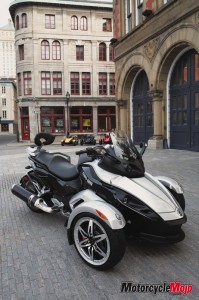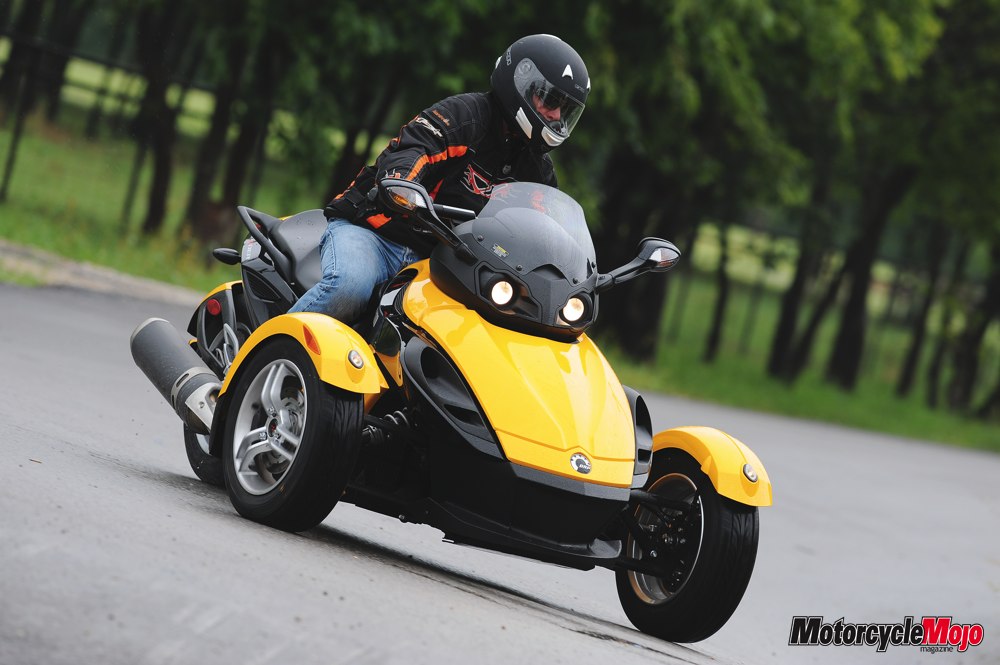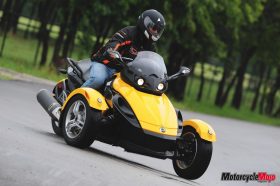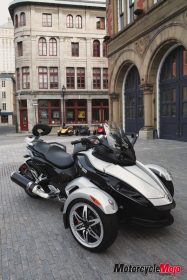Since Bombardier’s release of the Ski-Doo in the late-fifties, the company has been inventing niche markets, or paradigm shifts — a term that BRP personnel prefer to use — within the powersports industry.
In the late-sixties, Bombardier released another niche product, the first Personal Water Craft called the Sea-Doo. Then in 1972 they released the wildly popular Can-Am motorcycle for both competition and on- and off-road use. BRP is a world leader in most of the markets they are associated with. After a complete redesign of the Ski-Doo and the Sea-Doo, and with the acquisition of Evinrude and Johnson outboard motors, that statement has never been more true.
Bombardier sold off its recreational product line in 2003 and BRP was created, resurrecting the legendary Can-Am name. The 2007 launch of the BRP Spyder Roadster created yet another paradigm-shifting vehicle and yet another niche market. BRP realizes that any industry needs to be shaken up once in a while and what better way of doing that than to create a new market that gets people’s attention and makes them sit up and take notice.
It’s the second week of September in Grapevine, Texas, a suburb between Dallas and Fort Worth. The Weather Network now had a defined path for Hurricane Ike and it was soon to be bearing down on the Texas Gulf Coast. Our day to ride was Tuesday and according to the weather reports, Ike should be hitting the area like a ton of bricks on Friday. In theory, I should be back on Canadian soil before the fury of Hurricane Ike hits the Dallas area.
Knowing Ike’s ETA, we didn’t need to worry about the hurricane itself, but we did have lots of rain to deal with and the first thought on my mind was that our press contingent was in the leading edge of the devastating storm. Rainwater was pooling deep on the road making it quite dangerous for a number of reasons. With the Spyder’s dry vehicle weight of 316 kg (697 lbs) and the pair of wide 165/65R14 tires up front and the 225/50R15 rear tire leave open the possibility of hydroplaning. Also, the water was deep enough on many streets that once a front wheel hit the water, the tendency to be pulled toward the curb was a real concern. BRP personnel decided to knock off the morning ride early, go back for lunch, and take stock of the situation. While I would have liked to continue riding, although not necessarily in the rain, it was a good experience to see how the Spyder handled the wet weather, and which part of me got the wettest.
It seems that the aerodynamics of the Spyder does tend to pool water in the crotch area, but on the plus side, well placed body panels kept the bulk of the spray from the open front wheels away from my boots.
With nothing else like it on the road, this three-wheeled vehicle is unique in every way. At the morning briefing, it was quickly pointed out that with two wheels up front and one at the back, the Spyder is not a Trike, it is a Roadster!
When riding it (driving it?), my first impression was that of it being a very precise and stable street-legal go-cart that hangs onto corners like nothing I have ever ridden on the street before. The view from the seat is unique. Other than the instrument cluster and handlebars, the small fenders try to cover the open front wheels and the double A-Arm suspension offers a different outlook. Being able to see the wheels respond to the bumps in the road and the wheels responding to the riders steering inputs can only be likened to an open wheeled racecar.
While riding in the rain the rear tire would spin very easily on the wet roads and although that was fun for a short time, it soon became a bother. What I really wanted to feel was what this machine could do in the acceleration and cornering departments.
After lunch it was determined from satellite weather images that the area northwest of Dallas appeared to be the driest, so that’s the direction we aimed for. After about 45 minutes, the rain stopped and the roads were mostly dry.
SE5: The Big News for 2009
 The standard Spyder comes with a smooth-shifting manual five-speed transmission with left hand clutch lever and left foot shifting, but the big news for the 2009 Spyder (and some late-model 2008 Spyders) is the incorporation of a remarkable fully electronic clutchless five-speed gearbox. This new transmission is unlike anything I have experienced to date.
The standard Spyder comes with a smooth-shifting manual five-speed transmission with left hand clutch lever and left foot shifting, but the big news for the 2009 Spyder (and some late-model 2008 Spyders) is the incorporation of a remarkable fully electronic clutchless five-speed gearbox. This new transmission is unlike anything I have experienced to date.
Now don’t think for a minute that the SE5 is anything like a belt-driven CVT. It is a real transmission and real clutch, it’s just electronically controlled. Shifting is as easy as hitting the paddle on the left handgrip with your left thumb to upshift, or your left forefinger for downshift. In fact, you don’t even have to downshift if you forget, or if you just don’t want to. The ECU will downshift for you at the proper RPM and ensure you are in the appropriate gear in case you have to accelerate out of a situation quickly. The rider, however, is in full control of the upshift.
Both upshifting and downshifting is smooth and barely noticeable with only a very slight lag time between disengagement and engagement of the clutch. When you hit the upshift paddle, the ECU releases the clutch, shifts into the next gear and engages the clutch so smoothly you scarcely feel anything. During our morning briefing prior to riding the Spyder, Marc Lacroix, Product and Public Relations Manager at Can-Am Spyder, claimed that the whole shift operation from the time your thumb hits the button to the shift being complete is a mere 200 milliseconds, regardless of whether the shift is a hard shift at high RPM or a soft shift just putting around town. It is the same time frame for the downshift operation. On the SE5, the ECU will not permit a downshift if the RPM are so high to cause engine damage.
I was blown away with the smoothness and ease of use of the SE5 electronic transmission, but personally I preferred the clutch and manual transmission. I just felt something was missing in the riding experience by not clutching and changing gears manually.
No worries of how to back the Spyder up if you happen to park in a downhill parking spot. The Spyder has an easy to use true mechanical reverse. On the manual transmission, reverse is one gear below first. On the SE5, the reverse button is located on the left handlebar. The original gearbox that is used in the Spyder is a 6-speed, but BRP forfeited one of the gears for reverse. Final drive to the rear wheel is via a clean running, quiet, low-maintenance belt.
Power to the transmission comes by way of a BRP-Rotax 998 cc liquid-cooled, DOHC 4-valve V-Twin engine with Multi-point EFI and 57 mm diametre throttle bodies. The very smooth Rotax 990 delivers 106 horsepower at 8500 rpm and 77 lb-ft of torque at 6250 rpm with claims of 0-100 km/h in 4.5 seconds. Throttle response is instant with no hiccups and the exhaust note from the stock muffler sounds amazing. One of the press bikes had an accessory Hindle exhaust that was a fair bit louder than the stock. While it sounded good, I wonder if it would be too loud of a drone on a long trip.
Rotax is a wholly owned subsidiary of BRP and is well known for their engine development. Rotax has produced over 6-million engines to date and for many top name companies including KTM, BMW, Buell (the new 1125 cc Helicon V-Twin), Aprilia, and of course all of the engines in BRP’s product lines. While BRP calls the Spyder engine a 990, it is in fact the same 998 cc engine and 6-speed transmission in Aprilia’s RSV, Tuono and Caponord, albeit in different tune for more torque and better driveability making riding the Spyder a more user-friendly experience.
An acronym by any other name is just a bunch of letters. Or VSS, ABS, TCS, SCS and a bunch more letters.
Apart from getting speeding tickets, it would be hard to get into trouble on the Spyder Roadster. Not only is the ‘Y-Factor’, as it is described by BRP engineers, a very stable architecture, the Spyder is so technically advanced with so many safety features and computer controls that barring the laws of physics, the machine’s electronics will help keep you in control at all times.
With no less than five ECUs looking after machine and rider, all programmed by Bosch Systems, the main safety control is called VSS (Vehicle Stability System), a system that encompasses three main components-ABS (Anti-lock Braking System), TCS (Traction Control System), and SCS (Stability Control System with Roll-Over Mitigation). Also utilizing these ECUs are DPS (Dynamic Power Steering) and DESS (Digitally Encoded Security System). I know that is a lot of acronyms in one sentence, but I don’t make this stuff up. To help you absorb them I’ll go through each one individually to ease the confusion.
The Anti-lock Braking System is a no-brainer. ABS is nothing new in the automotive world and a number of motorcycles now sport ABS. While the Spyder’s rear tire easily lost traction in the rain, the brakes were the exact opposite and worked exceptionally well. The linked front and rear brakes are operated with a single right-side foot pedal and while I tried many times to activate the ABS, I experienced no reaction, most of the time. Only once, after really hammering on it, was I able to feel the ABS gently kick back. The dual front brakes boast four-piston calipers and 260 mm rotors on each wheel while the rear has a single-piston caliper and 260 mm rotor. The brakes slowed the vehicle abruptly while tires held on to the road surface like glue.
The Traction Control System is exactly as it’s described, traction control. I mentioned earlier about spinning the rear wheel in the wet and you would think that traction control means putting an end to rear wheel spin. The engineers at BRP and Bosch felt it necessary to leave in some ‘Fun Factor’, as the engineers called it. The rear wheel would spin providing three criteria are met; the steering has to be dead straight to prevent any fishtailing; no lateral movement is detected in the sensors; and the front wheels are turning less than 56 km/h (35 mph). If any of those conditions were outside the prescribed boundaries, the Traction Control ECU would intervene and cut the ignition, much the same way the engine reacts when bouncing off the rev limiter. If cutting the ignition didn’t slow the vehicle enough, the ECU would apply brakes.
The rear wheel would spin easily in the rain but the powerful and very responsive 990 Rotax engine would also spin the rear wheel on dry pavement with a touch more throttle, all the while launching you in a safe, straight line.
The SCS (Stability Control System with Roll-Over Mitigation) has to be the most advance system on the Spyder. The SCS helps to keep the vehicle level and more importantly, all three wheels touching the ground. Sensors detect the onset of wheel lift as well as excessive lateral movement by way of G-force sensors. If a wheel lifts, or if there is extraordinary lateral force, say in a high speed corner, the ECU will intervene much the same way the Traction Control is intervened, first by suspending the ignition and if that doesn’t work quick enough, it will begin braking the appropriate wheels to keep the machine level and stable in a corner. Apparently the system works because trying as hard as I could, I was not able to get the inside front wheel off the ground in a corner.
The VSS even utilizes a sensor under the rear seat that detects the presence of a passenger and the ECU adjusts its mapping accordingly for optimum traction and stability on the premise that the total vehicle weight and centre of gravity have changed.
So much thought and energy has been put into the VSS system that it actually has two ECUs, one is the primary ECU and the second one is redundant, a fail-safe system that only operates if the primary ECU fails for whatever reason. Apart from the laws of physics and inertia playing a role in trying to toss you off a high-speed corner, this very trick technology tries to overrule those laws of physics for your safety, comfort level and piece of mind.
The Dynamic Power Steering (DPS) determines the level of assist the rider puts into the steering system. This vehicle does not lean like a motorcycle so the steering at any speed is just that, steering. The handlebars must be turned and counter-steering does not apply. At low speed, the DPS offers more assist and therefore requires less strength from the rider to turn the steering. As the vehicle speed increases, less assist is provided making the vehicle feel much more stable at higher speeds. The system is not strictly a linear assist so also contributing to the algorithm are factors such as engine torque at any given time, wheel speed and road conditions. The DPS also incorporates a damper to isolate any road irregularities from reaching the rider. I did feel a slight engine buzziness through the handlebar but not enough to bother the rider.
The DPS worked very well by offering ‘feel’ to the steering system. After all, at speed you don’t want to over steer and this system helps to prevent that. I did find the steering a little twitchy on the highway tending to send the rider in the opposite direction. I based this feeling on my lack of experience on this type of vehicle and I’m sure that you would quickly get used to it.
The DESS (Digitally Encoded Security System) is nothing new to modern vehicles regardless of how many wheels they possess. In quick terminology, is it is a theft deterrent system.
The seating position is comfortable with feet below the hips keeping the lower back straight and hands ideally placed in front. The suspension worked as it should, providing a soft ride and while we didn’t hit any potholes, we did ride on a few rough roads. Suspension on all three wheels is adjustable for spring rate only. The seat did feel a little hard after a couple of hours, but the seat does provide lots of wiggle room to alleviate any sore spots.
The Spyder offers a generous 44 litres of storage in the forward trunk and an optional rear luggage rack to strap on a bag. If you are riding solo you also have the whole back seat for luggage. The small stock windshield does a good job of keeping the wind off of your chest, but leaves your head in the wind. There are a total of four various size windshields available.
All in all, I think the Spyder would make an ideal long distance touring machine. Many optional accessories are available to personalize your Spyder or make it more comfortable during the long haul. In creating this niche market, the BRP think tank first isolated the desired demographic.
It was determined that the ideal customer is between 35 and 55 who might be getting back into experiencing the open road, a well-informed and highly confidant individual that likes a challenge or is competitive, wants a rush without unnecessary risk because of family commitments and possibly already has some type of powersport vehicle. But let’s not forget about those individuals with disabilities, those riders who are increasing in age or don’t feel they have the leg strength or the balance to hold up a motorcycle.
This could be the perfect rider-friendly road worthy hot-rod that offers the excitement and performance of a motorcycle and the comfort and piece of mind of a sports car, and believe me, it is a lot of fun. Value your playtime!
Prices start at $18,999 for the SM5 Manual transmission and $20,499 for the SE5 Electronic transmission. Go to www.brp.com or see your local dealer for more information.
















